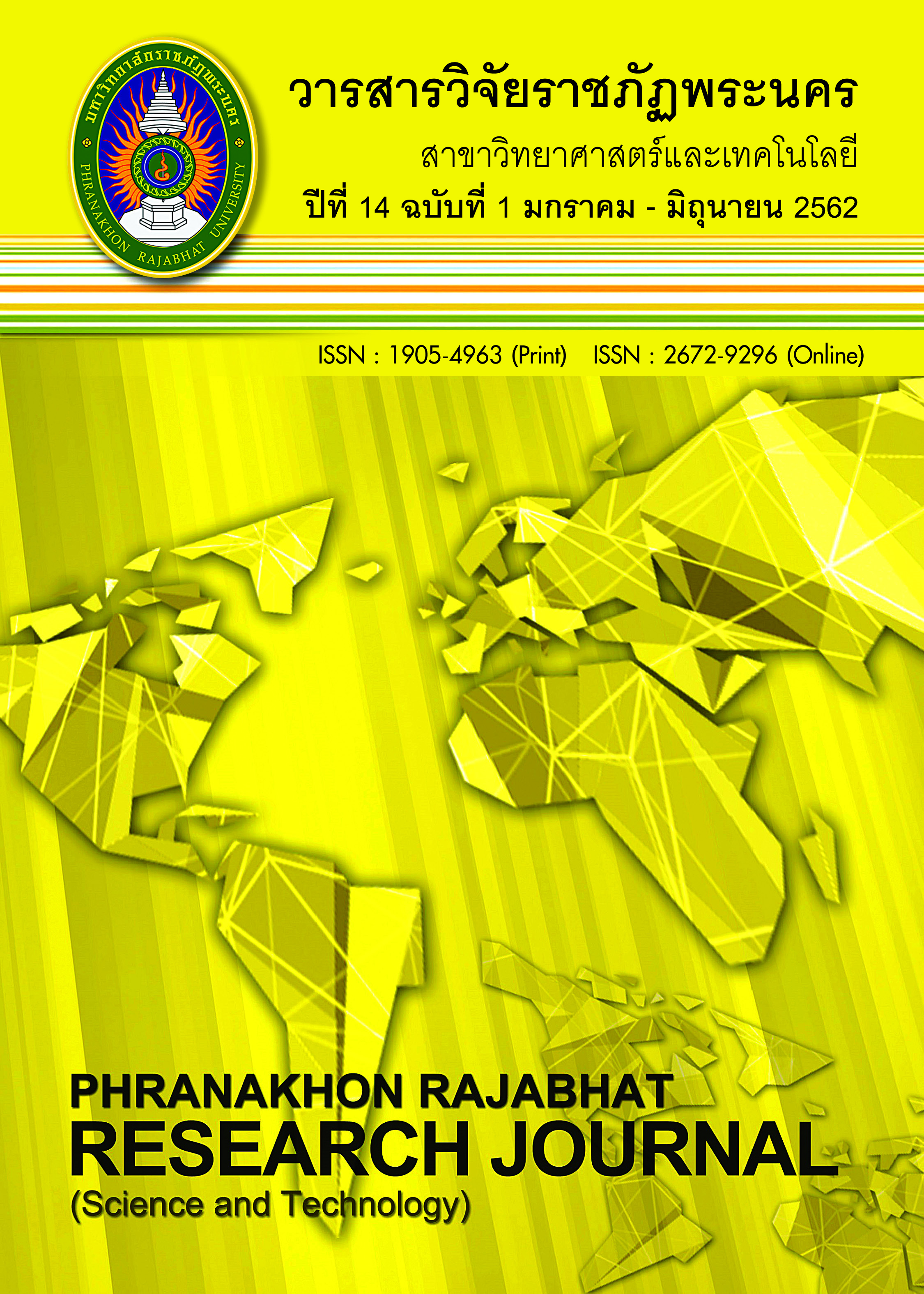YELLOWING DEVELOPMENT OF CHINESE KALE (Brassica oleracea var. alboglabla)
Keywords:
Chinese Kale, chlorophyll, yellowing, shelf lifeAbstract
Chinese Kale is a popular vegetable especially for Cantonese cuisine that a yellowing is a major problem. This research, therefore, aimed to study the development of physical yellowing at each leaf’s position and on a leaf of kale. The four leaflets plants were used that the top leaf was count as the 1st leaf and the most outer leaf was the 4th leaf, and each leaf was equally divided into 3 parts which were upper, middle, and lower. The plants then were stored at room temperature (30±2 °C, relative humidity of 60-70) until end of shelf life. The color changing analysis (L *, a *, b * and hue), SPAD value, chlorophyll a, chlorophyll b, and total chlorophyll were used to determine the yellowing of kale in every day. The results showed a trend that the fourth leaf, which is the outer leaf, developed fastest yellow color and followed by the 3rd, the 2nd and the 1st leaf, respectively (p =< 0.01). Whereas, the yellowing development on each part of a leaf was not significantly different (p> 0.05). As consumer evaluation, only 1 day of storage is acceptable for selling, however, it can be accepted for consumption up to the 3rd day of storage.
References
67(3), 243-256.
Buchanan-Wollaston, V. (1997). The molecular biology of leaf senescence. Journal of Experimental Botany. 48(2), 181-199.
Ferrante, A. & Maggiore, T. (2007). Chlorophyll a fluorescence measurements to evaluate storage time and temperature of of Valeriana leafy vegetables. Postharvest Biology and Technology. 45, 73-80.
Hasperué, J.H., Gómez-Lobato, M.E., Chaves, A.R., Civello, P.M. & Martínez, G.A. (2013). Time of day at harvest affects the expression of chlorophyll degrading genes during postharvest storage of broccoli. Postharvest Biology and
Technology. 82, 22-27.
Klieber, A., Porter, K.L. & Collins, G. (2002). Harvesting at different times of day does not influence the postharvest life of Chinese cabbage. Scientia Horticulturae. 96(1), 1-9.
Kornsongkaew, B. (2006). Effect of hydro-cooling and modified atmosphere packaging on quality and storage life of minimally processed Chinese Kale (Brassica alboglabra Bailey). Master Program in Postharvest Technology, School of
Bioresources and Technology Faculty, King Mongkut’s University of Technology Thonburi. (In Thai)
Limantara, L., Dettling, M., Indrawati, R., Indriatmoko. & Brotosudarmo, T.H.P. (2015). Analysis on the chlorophyll content of commercial green leafy vegetables. Procedia Chemistry. 14, 225-231.
Ma, G., Wang, R., Wang, C.R., Kato, M., Yamawaki, K., Qin, F. & Xu, H.L. (2009). Effect of 1- methylcyclopropene on expression of genes for ethylene biosynthesis enzymes and ethylene receptors in post-harvest broccoli. Plant Growth
Regulation. 57(3), 223-232.
Mutui, T.M., Mibus, H. & Serek, M. (2012). Effect of meta-topolin on leaf senescence and rooting in Pelargonium x hortorum cuttings. Postharvest Biology and Technology. 63(1), 107-110.
Noichinda, S., Bodhipadma, K., Mahamontri, C., Narongruk, T. & Ketsa, S. (2007). Light during storage prevents loss of ascorbic acid, and increase glucose and fructose levels in Chinese kale (Brassica oleracea var. alboglabla). Posthavest Biology and Technology. 44, 312-315.
Poochai, S., Ketsa, S. & Kosiyachinda, S. (1984). Effects of temperatures and packing materials on quality and storage life of Chinese kale (Brassica oleracea var. alboglabla D.C.). Kasetsart Journal (Natural Science) 18, 1-6.
Qiu, Y., Zhao, Y., Liu, J. & Guo, Y. (2017). A statistical analysis of the freshness of postharvest leafy vegetables with application of water based on chlorophyll fluorescence measurement. Information Processing in Agriculture. 4, 269-274.
Quirino, B.F., Noh, Y-S., Himelblau, E. & Amasino, R.M. (2000). Molecular aspects of leaf senescence. Trends in Plant Science. 5(7), 278-282.
Robinson, J.E., Browne, K.M. & Burton, W.G. (1975). Storage Characteristics of some vegetables and soft fruits. Annual Applied Biology. 81, 399-408
Sánchez, C., Baranda, A.B. & Marañónet, I.M. (2014). The effect of high Pressure and high temperature processing on carotenoids and chlorophylls content in some vegetables. Food Chemistry. 163, 37-45.
Shi, J., Gao, L., Zuo, J., Wang, Q., Wang, Q. & Fan, L. (2016). Exogenous sodium nitroprusside treatment of broccoli florets extends shelf life, enhances antioxidant enzyme activity, and inhibits chlorophyll-degradation Postharvest
Biology and Technology. 116, 98-104.
Sumniengdee, P. (2012). Effect of ethephon, 6-benzylaminopurine, methyl jasmonate and salicylic acid on leaf yellowing of Chinese kale (Brassica alboglabra var.alboglabra). Master Program in Postharvest Technology, School
of Bioresources and Technology Faculty, King Mongkut’s University of Technology Thonburi. (In Thai)
Sun, Y. & Li, W. (2017). Effects the mechanism of micro-vacuum storage on broccoli chlorophyll degradation and builds prediction model of chlorophyll content based on the color parameter changes. Scientia Horticulturae. 224, 206-214.
Sun, B., Zhang, F., Xiao, N., Jiang, M., Yuan, Q., Xue, S., Miao, H., Chen, Q., Li, M., Wang, L., Wang, X., Wang, Q. & Tang, H. (2018). An efficient mesophyll protoplast isolation, purification and PEG-mediated transient gene expression for subcellular localization in Chinese kale. Scientia Horticulturae. 241, 187-193.
Tang, L., Wang, C., Huang, J., Zhang, J., Mao, Z. & Wang, H. (2013). Comparative analysis of peroxidase profiles in Chinese kale (Brassica alboglabra L.): evaluation of leaf growth related isozymes. Food Chemistry. 136, 632-635.
Wanwimolruk, S., Kanchanamayoon, O., Phopin,K. & Prachayasittikul, V. (2015). Food safety in Thailand 2: Pesticide residues found in Chinese Kale (Brassica oleracea), a commonly consumed vegetable in Asian countries. Science of
the Total Environment. 532, 447-455.
Wilson, D.W., Barwick, J.M., Lomax, J.A., Jarvis, M.C. & Duncan, H.J. (1988). Lignified and non-lignified cell walls from kale. Plant Science. 57(1), 83-90.
Yamauchi, N., Harada, K. & Watada, A.E. (1997). In vitro chlorophyll degradation in stored broccoli (Brassica oleraceae L. var. italic Plen.) florets. Postharvest Biology and Technology. 12, 239-245.
Žnidarčič, D., Ban, D. & Šircelj, H. (2011). Carotenoid and Chlorophyll composition of commonly consumed leafy vegetables in Mediterranean countries. Food Chemistry. 129, 1164-1168.
Downloads
Published
Issue
Section
License
โปรดกรอกเอกสารและลงนาม "หนังสือรับรองให้ตีพิมพ์บทความในวารสารวิจัยมหาวิทยาลัยราชภัฏพระนคร สาขาวิทยาศาสตร์และเทคโนโลยี" ก่อนการตีพิมพ์




